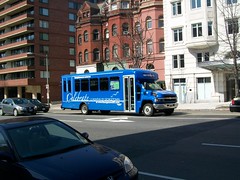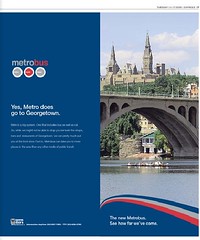What's wrong with this Metrobus ad? (Express, 11/17/2009, p. 7)
At first, I looked at this and thought, "wow, it's graphically attractive." But that reaction passed very quickly.
When I first came to Washington, I worked for a consumer group that publishes one of the largest circulation newsletters in North America, a newsletter with hundreds of thousands of subscribers. (In fact, one of my ideas makes them about $3 million/year, even though it took them 6 years to implement it...)
It was a great opportunity to learn about direct marketing, which is focused on results, response, tracking, and testing.
The big thing in direct marketing is to make your ads/mailings etc. be actionable--meaning there is a response device or the information necessary to make you act the way the marketer desires and intends.
1. This isn't the image that depicts why people go to Georgetown. Think images of shopping, positive street activity, night life, instead of this sedate postcard view.
These aren't great images, but you get the idea that the point of Georgetown is vibrancy not somnambulance.


2. Mention that parking is expensive and traffic sucks, especially on Thursday, Friday, and Saturday nights. (Show a photo of a sign saying how much it costs to park in one of the parking garages...)
3. List the bus routes that serve Georgetown!!!!!!!!!!!!!!!!!!!!!
How do you expect people to use the bus to get to Georgetown if they don't know what buses to use?
4. This is tricky because the Circulator and Georgetown Connector buses (the latter providing service between the Rosslyn and Dupont Circle Metro stations via Georgetown) aren't run by WMATA, but are paid for out of DC funds. (WMATA does have a management relationship somehow with the Circulator, but the service is basically run by a division of the Downtown DC Business Improvement District.)
So marketing the idea of less traffic, use transit, etc., is complicated here because WMATA isn't the only stakeholder.
5. Although my point that if DC would create transportation management districts, TMDs such as within Georgetown could market better transportation decisionmaking -- like using public transit.
6. AND DON"T FORGET to mention that you can get to Georgetown via Metro by getting off at the Rosslyn station and walking across the Key Bridge.
------
I would have done this ad differently, with a collage of photos showing shopping, dining, entertainment, and transportation, the street etc.
----
Note that many other cities do a better job of marketing transit. Many places will run ads and include information on how to get there by various modes, including transit. You'd think this would happen more here, given the prevalence of the subway system. But it doesn't show up as much as you'd expect.

Georgetown Connector bus.




0 Comments:
Post a Comment
<< Home